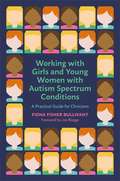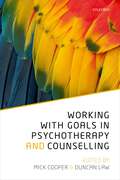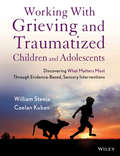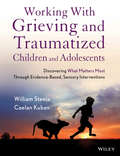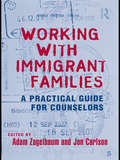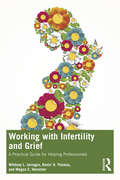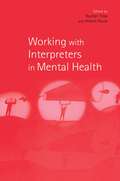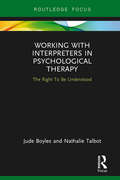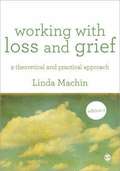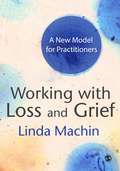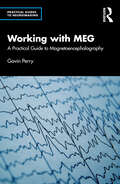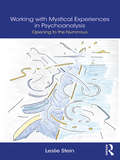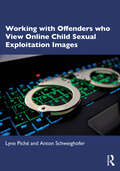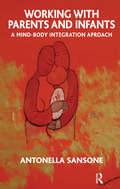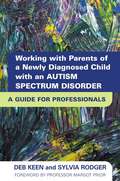- Table View
- List View
Working with Girls and Young Women with an Autism Spectrum Condition: A Practical Guide for Clinicians
by Fiona Fisher BullivantThis guide shows how clinicians can help girls and young women with ASC to reach their full potential, by adopting more relationship-based, individualised approaches. With contributions from young women about their experiences in clinical settings, the book reflects on what clinicians have done right and wrong to date, why girls and women with ASC are too often misunderstood, and how the culture of how clinicians work with them needs to change in order to achieve better results. In a concise and practical way, it covers how to better understand clients' needs and foster strong relationships through diagnosis, understanding comorbidities, sensory issues, self-harm, emotional regulation, assessments, interventions and strategies.
Working with Girls and Young Women with an Autism Spectrum Condition: A Practical Guide for Clinicians (PDF)
by Fiona Fisher BullivantThis guide shows how clinicians can help girls and young women with ASC to reach their full potential, by adopting more relationship-based, individualised approaches. With contributions from young women about their experiences in clinical settings, the book reflects on what clinicians have done right and wrong to date, why girls and women with ASC are too often misunderstood, and how the culture of how clinicians work with them needs to change in order to achieve better results. In a concise and practical way, it covers how to better understand clients' needs and foster strong relationships through diagnosis, understanding comorbidities, sensory issues, self-harm, emotional regulation, assessments, interventions and strategies.
Working with Goals in Psychotherapy and Counselling
by Mick Cooper and Duncan LawRecent evidence has shown that the successful setting of goals brings about positive outcomes in psychological therapy. Goals help to focus and direct clients' and therapists' attention in therapeutic work. They also engender hope and help energise clients. No longer are clients victims of their circumstances, but through goal setting they become people who have the potential to act towards and achieve their desired futures. Through the discussing and setting of goals, clients develop a deeper insight into what it is that they really want in life: a crucial first step towards being able to get there. Recent policies in both child and adult mental health services have supported the use of goals in therapy. However, the differing cultures, histories, psychologies, and philosophical assumptions of each form of therapy has brought about varying attitudes and approaches to goal setting. Working with Goals in Counselling and Psychotherapy brings the attitudes of all the major therapeutic orientations together in one volume. With examples from cognitive behaviour therapy, psychodynamic therapy, humanistic therapy, interpersonal therapy, and systemic therapy Working with Goals in Counselling and Psychotherapy truly is the definitive guide for therapists seeking to work with goals in any of the psychological therapies.
Working with Goals in Psychotherapy and Counselling
Recent evidence has shown that the successful setting of goals brings about positive outcomes in psychological therapy. Goals help to focus and direct clients' and therapists' attention in therapeutic work. They also engender hope and help energise clients. No longer are clients victims of their circumstances, but through goal setting they become people who have the potential to act towards and achieve their desired futures. Through the discussing and setting of goals, clients develop a deeper insight into what it is that they really want in life: a crucial first step towards being able to get there. Recent policies in both child and adult mental health services have supported the use of goals in therapy. However, the differing cultures, histories, psychologies, and philosophical assumptions of each form of therapy has brought about varying attitudes and approaches to goal setting. Working with Goals in Counselling and Psychotherapy brings the attitudes of all the major therapeutic orientations together in one volume. With examples from cognitive behaviour therapy, psychodynamic therapy, humanistic therapy, interpersonal therapy, and systemic therapy Working with Goals in Counselling and Psychotherapy truly is the definitive guide for therapists seeking to work with goals in any of the psychological therapies.
Working with Grieving and Traumatized Children and Adolescents: Discovering What Matters Most Through Evidence-Based, Sensory Interventions
by William Steele Caelan KubanPraise for Working With Grieving and Traumatized Children and Adolescents "This much-needed book effectively argues for the use of structured activities as the basis for exploring trauma-specific questions in clinical work with traumatized children and adolescents. Numerous examples of children's artwork enhance the book and illustrate the effectiveness of the treatment. The authors' methods have been used successfully for many years and represent a major contribution to the study of trauma that will be welcomed by both students and seasoned practitioners." —Nancy Boyd Webb, DSW, LICSW, RPT-S Professor of Social Work Emerita, Fordham University, Author: Play Therapy With Children in Crisis "The authors provide a clear theoretical framework and demonstrate practical sensory-based activities so kids can discover and reconnect with their bodies' agency and vitality. Refreshingly, this vehicle creates an emotionally safe journey for the child into the mystery of the experiential, embedded in implicit memory. It's chock-full of invitations to explore self-impressions and worldviews in a way that children feel seen, not assessed." —Peter A. Levine, PhD, and Maggie Kline, MS, LMFT, Coauthors: Trauma Through a Child's Eyes and Trauma-Proofing Your Kids A structured, sequential, and evidence-based approach for the treatment of children and adolescents experiencing trauma or grief Working With Grieving and Traumatized Children and Adolescents features the Structured Sensory Interventions for Traumatized Children, Adolescents and Parents (SITCAP) intervention model, proven in successfully addressing violent situations such as murder, domestic violence, and physical abuse, as well as non-violent grief- and trauma-inducing situations including divorce, critical injuries, car fatalities, terminal illness, and environmental disasters. Filled with practical and proven activities for use with children and adolescents experiencing trauma and grief, this resource is based on the authors' experience working with all types of traumatic events in school-, agency-, and community-based programs across the country.
Working with Grieving and Traumatized Children and Adolescents: Discovering What Matters Most Through Evidence-Based, Sensory Interventions
by William Steele Caelan KubanPraise for Working With Grieving and Traumatized Children and Adolescents "This much-needed book effectively argues for the use of structured activities as the basis for exploring trauma-specific questions in clinical work with traumatized children and adolescents. Numerous examples of children's artwork enhance the book and illustrate the effectiveness of the treatment. The authors' methods have been used successfully for many years and represent a major contribution to the study of trauma that will be welcomed by both students and seasoned practitioners." —Nancy Boyd Webb, DSW, LICSW, RPT-S Professor of Social Work Emerita, Fordham University, Author: Play Therapy With Children in Crisis "The authors provide a clear theoretical framework and demonstrate practical sensory-based activities so kids can discover and reconnect with their bodies' agency and vitality. Refreshingly, this vehicle creates an emotionally safe journey for the child into the mystery of the experiential, embedded in implicit memory. It's chock-full of invitations to explore self-impressions and worldviews in a way that children feel seen, not assessed." —Peter A. Levine, PhD, and Maggie Kline, MS, LMFT, Coauthors: Trauma Through a Child's Eyes and Trauma-Proofing Your Kids A structured, sequential, and evidence-based approach for the treatment of children and adolescents experiencing trauma or grief Working With Grieving and Traumatized Children and Adolescents features the Structured Sensory Interventions for Traumatized Children, Adolescents and Parents (SITCAP) intervention model, proven in successfully addressing violent situations such as murder, domestic violence, and physical abuse, as well as non-violent grief- and trauma-inducing situations including divorce, critical injuries, car fatalities, terminal illness, and environmental disasters. Filled with practical and proven activities for use with children and adolescents experiencing trauma and grief, this resource is based on the authors' experience working with all types of traumatic events in school-, agency-, and community-based programs across the country.
Working With Immigrant Families: A Practical Guide for Counselors (Routledge Series on Family Therapy and Counseling)
by Adam ZagelbaumThis book aims to create a foundation that respects theory, culture, and the mental health professions and to initiate the practical and needed discussions about how to work with immigrant families.
Working With Immigrant Families: A Practical Guide for Counselors (Routledge Series on Family Therapy and Counseling)
by Adam Zagelbaum Jon CarlsonThis book aims to create a foundation that respects theory, culture, and the mental health professions and to initiate the practical and needed discussions about how to work with immigrant families.
Working with Infertility and Grief: A Practical Guide for Helping Professionals
by Whitney L. Jarnagin Denis' A. Thomas Megan C. HerscherWorking with Infertility and Grief: A Practical Guide for Helping Professionals explores issues of grief, including disenfranchised grief and chronic sorrow, related to infertility and reproductive loss. Out of the small handful of books related to this topic, this is the first of its kind geared toward equipping helping professionals who assist those grieving unrecognized losses. Written through the lens of the literary framework of The Hero’s Journey, this comprehensive practitioner guide directly targets mental health professionals working with clients, supervisees, or students who have experienced infertility, miscarriage, or death of an infant. This book is also for those who experienced it themselves. Readers will learn more about the crisis of infertility and reproductive loss, gain insight into the experience of those suffering, and acquire practical tools and strategies for helping and healing. This text is broad enough to be integrated into a course for a graduate program and specific enough to serve as a shelf reference for those in practice.
Working with Infertility and Grief: A Practical Guide for Helping Professionals
by Whitney L. Jarnagin Denis' A. Thomas Megan C. HerscherWorking with Infertility and Grief: A Practical Guide for Helping Professionals explores issues of grief, including disenfranchised grief and chronic sorrow, related to infertility and reproductive loss. Out of the small handful of books related to this topic, this is the first of its kind geared toward equipping helping professionals who assist those grieving unrecognized losses. Written through the lens of the literary framework of The Hero’s Journey, this comprehensive practitioner guide directly targets mental health professionals working with clients, supervisees, or students who have experienced infertility, miscarriage, or death of an infant. This book is also for those who experienced it themselves. Readers will learn more about the crisis of infertility and reproductive loss, gain insight into the experience of those suffering, and acquire practical tools and strategies for helping and healing. This text is broad enough to be integrated into a course for a graduate program and specific enough to serve as a shelf reference for those in practice.
Working with Interpreters in Mental Health
by Hitesh Raval Rachel TribeWhy are interpreters an important part of modern healthcare provision?In today's society, there is an increasing need for mental health professionals to work with interpreters, yet coverage of this subject in the existing literature is scarce. Working with Interpreters in Mental Health gives an insight into the issues and problems of professionals working with interpreters in the mental health field.Informed by theoretical, research and practice considerations, Working with Interpreters in Mental Health helps practitioners to develop better ways of helping service users who need an interpreter. Combining contributions from a number of different disciplines, this book discusses:* interpreters in medical consultations* issues of language provision in health care services* the application of theoretical frameworks to the work with interpreters* the work of interpreters in a variety of practical settings.Whilst the focus the placed within a mental health context, many of the issues raised apply equally to other context where interpreters are needed. This book will be invaluable for practitioners of psychology, psychiatry, social work and other health professionals.
Working with Interpreters in Mental Health
by Rachel Tribe Hitesh RavalWhy are interpreters an important part of modern healthcare provision?In today's society, there is an increasing need for mental health professionals to work with interpreters, yet coverage of this subject in the existing literature is scarce. Working with Interpreters in Mental Health gives an insight into the issues and problems of professionals working with interpreters in the mental health field.Informed by theoretical, research and practice considerations, Working with Interpreters in Mental Health helps practitioners to develop better ways of helping service users who need an interpreter. Combining contributions from a number of different disciplines, this book discusses:* interpreters in medical consultations* issues of language provision in health care services* the application of theoretical frameworks to the work with interpreters* the work of interpreters in a variety of practical settings.Whilst the focus the placed within a mental health context, many of the issues raised apply equally to other context where interpreters are needed. This book will be invaluable for practitioners of psychology, psychiatry, social work and other health professionals.
Working with Interpreters in Psychological Therapy: The Right To Be Understood (Routledge Focus on Mental Health)
by Jude Boyles Nathalie TalbotThis book is a practical and helpful guide for therapists that outlines best practice in working with interpreters. It provides an accessible tool for therapists working in a range of settings from small unfunded therapy teams in the voluntary sector to primary care work. Working with Interpreters in Psychological Therapy has been written collaboratively by a therapist and an interpreter working in the refugee sector. The writers reflect upon how therapists can manage some of the complex dynamics that can occur in the triadic relationship and explore how the presence of an interpreter can bring additional psychological benefits to clients. This book is essential reading for therapists working in cross-cultural settings, as well as the organizations in which they work.
Working with Interpreters in Psychological Therapy: The Right To Be Understood (Routledge Focus on Mental Health)
by Jude Boyles Nathalie TalbotThis book is a practical and helpful guide for therapists that outlines best practice in working with interpreters. It provides an accessible tool for therapists working in a range of settings from small unfunded therapy teams in the voluntary sector to primary care work. Working with Interpreters in Psychological Therapy has been written collaboratively by a therapist and an interpreter working in the refugee sector. The writers reflect upon how therapists can manage some of the complex dynamics that can occur in the triadic relationship and explore how the presence of an interpreter can bring additional psychological benefits to clients. This book is essential reading for therapists working in cross-cultural settings, as well as the organizations in which they work.
Working with Loss and Grief: a Theoretical and Practical Approach (PDF)
by Linda MachinThis updated second edition of Working with Loss and Grief provides a model for practitioners working with those who are grieving a significant life loss. Making clear connections between theory and practice, the 'Range of Response to Loss' model provides a theoretical 'compass' for recognising the wide variability in reaction to loss and the 'Adult Attitude to Grief' scale is a tool for 'mapping' individual grief and its change over time, providing an individual grief profile. Together these offer a framework for practitioners to: -listen to stories of grief told by clients -identify common patterns in grief -recognize individual difference in grief response -make assessments -prompt therapeutic dialogue -guide therapeutic focus and -evaluate outcomes. This edition includes: a new chapter on 'The RRL Model and a Pluralistic Approach to Counselling' ; two new case studies; additional content on vulnerability; new grief assessment tools and systems, and the latest research. Dr Linda Machin is Honorary Research Fellow at Keele University, having been a Lecturer in Social Work and Counselling at Keele. She established a counselling service for the bereaved in North Staffordshire and continues to work as a researcher and freelance trainer.
Working with Loss and Grief: A New Model for Practitioners (PDF)
by Linda Machin'In a book that is replete with illustrative case studies, Linda Machin draws together the findings of a wide range of psychological and sociological theory and research in order to develop a way of thinking about grief and loss that is intelligible to ordinary mortals. Her Adult Attitude to Grief scale promises to be a useful tool by which problems can be identified and progress monitored' - Colin Murray Parkes, Honorary Consultant Psychiatrist to St. Christopher's Hospice Loss is a universal human experience. Supporting those who are grieving a significant life loss is a key role for many professionals in health and social care settings and is the focus in many voluntary organisations. Although there is an extensive literature on loss and bereavement, practitioners often struggle to see how to put theory into practice. Working with Loss and Grief provides a new model which makes clear connections between theory and practice. The 'Range of Response to Loss' model provides a theoretical 'compass' for recognising the wide variability in reaction to loss and the 'Adult Attitude to Grief' scale is a tool for 'mapping' individual grief and its change over time, providing an individual grief profile. Together these offer a framework for practitioners to: " Listen to stories of grief told by clients " Identify common patterns in grief; " Recognize individual difference in grief response " Assess the need for therapeutic intervention or support " Prompt therapeutic dialogue " Guide therapeutic focus " Appraise clients " Evaluate outcomes. Case examples show that the experience of grief is highly individual, but also capable of being understood in terms of general concepts. As such it is a valuable resource not only for practitioners and trainees in counselling and social work, but also for psychologists, doctors, nurses, and for researchers studying loss and grief. Dr Linda Machin is a Visiting Research Fellow of Keele University, having been a Lecturer in Social Work and Counselling at Keele. She established a counselling service for the bereaved in North Staffordshire and continues to work as a researcher, a hospice counsellor and a freelance trainer.
Working with MEG (Practical Guides to Neuroimaging)
by Gavin PerryIn 1968 at the University of Illinois, David Cohen made scientific history when he measured a neuronal oscillation known as the alpha rhythm from the brains of four human volunteers. The measurement of the alpha rhythm was not in itself a breakthrough: the German psychiatrist, Hans Berger, had discovered the rhythm decades earlier during his first recordings of human electroencephalography (EEG). What was novel about Cohen’s experiment was that it did not measure electrical potentials on the scalp as is the case for EEG. Instead, the measurements were made using a metal coil built to measure magnetic fields. Cohen had become the first person to measure the brain’s magnetic field and in doing so had pioneered an entirely new method for measuring the brain’s activity: magnetoencephalograpy (MEG). In the intervening decades MEG has grown from a highly specialised method practiced by a small number of researchers to a routine method of human neuroscience available at laboratories across the world. However, as the use of MEG has increased, so too has the number of people encountering MEG for the first time, and this has created a growing need for materials that aid the understanding of MEG for those with no prior experience.
Working with MEG (Practical Guides to Neuroimaging)
by Gavin PerryIn 1968 at the University of Illinois, David Cohen made scientific history when he measured a neuronal oscillation known as the alpha rhythm from the brains of four human volunteers. The measurement of the alpha rhythm was not in itself a breakthrough: the German psychiatrist, Hans Berger, had discovered the rhythm decades earlier during his first recordings of human electroencephalography (EEG). What was novel about Cohen’s experiment was that it did not measure electrical potentials on the scalp as is the case for EEG. Instead, the measurements were made using a metal coil built to measure magnetic fields. Cohen had become the first person to measure the brain’s magnetic field and in doing so had pioneered an entirely new method for measuring the brain’s activity: magnetoencephalograpy (MEG). In the intervening decades MEG has grown from a highly specialised method practiced by a small number of researchers to a routine method of human neuroscience available at laboratories across the world. However, as the use of MEG has increased, so too has the number of people encountering MEG for the first time, and this has created a growing need for materials that aid the understanding of MEG for those with no prior experience.
Working with Mystical Experiences in Psychoanalysis: Opening to the Numinous
by Leslie SteinA mystical experience, no matter what else, is a subjective occurrence in the psyche. However, when it appears in the psychoanalytic consulting room, its origin, content, and meaning are unknowable. Yet it is there in the room, and it must be addressed. It is not a minor illusion but rather one that requires attention as its occurrence may lead to a profound alteration of consciousness and, as Carl Jung suggests, a cure for neurosis. Leslie Stein interviewed twenty-nine mystics in order to understand the origin, progression, phasing, emotions, and individual variations of a mystical experience in order to make sense of how it should be addressed, the appropriate analytic attitude in the face of a mystery, the way to work with its content, and its psychological meaning. In doing so, he uncovered that there may be specific development markers that create a proclivity to be receptive to such an experience that has clinical significance for psychoanalysis.
Working with Mystical Experiences in Psychoanalysis: Opening to the Numinous
by Leslie SteinA mystical experience, no matter what else, is a subjective occurrence in the psyche. However, when it appears in the psychoanalytic consulting room, its origin, content, and meaning are unknowable. Yet it is there in the room, and it must be addressed. It is not a minor illusion but rather one that requires attention as its occurrence may lead to a profound alteration of consciousness and, as Carl Jung suggests, a cure for neurosis. Leslie Stein interviewed twenty-nine mystics in order to understand the origin, progression, phasing, emotions, and individual variations of a mystical experience in order to make sense of how it should be addressed, the appropriate analytic attitude in the face of a mystery, the way to work with its content, and its psychological meaning. In doing so, he uncovered that there may be specific development markers that create a proclivity to be receptive to such an experience that has clinical significance for psychoanalysis.
Working with Offenders who View Online Child Sexual Exploitation Images
by Lyne Piché Anton SchweighoferThis comprehensive workbook addresses the use of illegal online sexual images. Focusing specifically on child sexual exploitation materials (CSEM), it offers a clear and professional manual for use with men who use CSEM. Working with clients who access illegal online images is challenging work. CSEM clients have unique characteristics and treatment needs. Designed around practitioner and client needs, each chapter provides a guide for clinicians and a subsequent set of materials for the client. The workbook covers a range of topics such as motivation for change, relationships, thinking patterns, emotions management, sexuality, computer use, Internet safety and future strategies to ensure both client and community safety. Addressing these issues as well as community accountability helps users of CSEM achieve a satisfying life while avoiding future criminal justice involvement. Through this clearly written and structured workbook, clients are given the resources to help manage problematic thoughts and/or illegal sexual behaviour. Offering evidence-based strategies rooted in the authors’ clinical experiences, the workbook enables the practitioner and client to work productively together to address the issues that have led to their involvement with illegal sexual images. This book will be helpful to a range of practitioners including forensic and clinical psychologists, as well as those working in correctional settings, such as probation and prison staff, psychiatrists, social workers, counsellors and providers of mental health treatment. It is also designed for anyone who has viewed, or is worried about viewing, sexual images of children.
Working with Offenders who View Online Child Sexual Exploitation Images
by Lyne Piché Anton SchweighoferThis comprehensive workbook addresses the use of illegal online sexual images. Focusing specifically on child sexual exploitation materials (CSEM), it offers a clear and professional manual for use with men who use CSEM. Working with clients who access illegal online images is challenging work. CSEM clients have unique characteristics and treatment needs. Designed around practitioner and client needs, each chapter provides a guide for clinicians and a subsequent set of materials for the client. The workbook covers a range of topics such as motivation for change, relationships, thinking patterns, emotions management, sexuality, computer use, Internet safety and future strategies to ensure both client and community safety. Addressing these issues as well as community accountability helps users of CSEM achieve a satisfying life while avoiding future criminal justice involvement. Through this clearly written and structured workbook, clients are given the resources to help manage problematic thoughts and/or illegal sexual behaviour. Offering evidence-based strategies rooted in the authors’ clinical experiences, the workbook enables the practitioner and client to work productively together to address the issues that have led to their involvement with illegal sexual images. This book will be helpful to a range of practitioners including forensic and clinical psychologists, as well as those working in correctional settings, such as probation and prison staff, psychiatrists, social workers, counsellors and providers of mental health treatment. It is also designed for anyone who has viewed, or is worried about viewing, sexual images of children.
Working with Parents and Infants: A Mind-Body Integration Approach
by Antonella SansoneWorking with Parents and Infants is aimed at understanding the process of psychosomatic illness, exploring the embodiment of psychosomatic health and illness, and the inseparability of psyche and soma. Within this book, the author highlights the beneficial function of psychosomatic symptoms, such as mastitis, in signalling to the counsellor or therapist as well as the patient the need for change and the path through which it may occur. Research and clinical literature have often overlooked the relationship between the woman's attitude to her bodyself, thus her mind-body integration, breastfeeding and the quality of interactions with her baby. A psychosomatic disturbance is in this book conceived as an impaired sense of bodyself, or in other words, a lack of psycho-soma integration. The author presents a new approach to health and the healing relationship emerging from a meeting between Eastern meditative disciplines and Western psychological practise.
Working with Parents and Infants: A Mind-Body Integration Approach
by Antonella SansoneWorking with Parents and Infants is aimed at understanding the process of psychosomatic illness, exploring the embodiment of psychosomatic health and illness, and the inseparability of psyche and soma. Within this book, the author highlights the beneficial function of psychosomatic symptoms, such as mastitis, in signalling to the counsellor or therapist as well as the patient the need for change and the path through which it may occur. Research and clinical literature have often overlooked the relationship between the woman's attitude to her bodyself, thus her mind-body integration, breastfeeding and the quality of interactions with her baby. A psychosomatic disturbance is in this book conceived as an impaired sense of bodyself, or in other words, a lack of psycho-soma integration. The author presents a new approach to health and the healing relationship emerging from a meeting between Eastern meditative disciplines and Western psychological practise.
Working with Parents of a Newly Diagnosed Child with an Autism Spectrum Disorder: A Guide for Professionals
by Deb Keen Sylvia RodgerFinding out that a child has an autism spectrum disorder (ASD) can put an enormous strain on families, and the quality of support offered by professionals at this time can make a huge difference to how they adjust to the news. This book comprehensively sets out the type of support that is most beneficial to families immediately following an ASD diagnosis, and will equip professionals with the information and tools they need to best provide that support. The authors provide all of the key information professionals supporting families at the time of an ASD diagnosis need to know about the diagnostic criteria of ASD, key characteristics, aetiology, prevalence, and prognosis, and explain how to pass on accurate and meaningful information to families, and how to build effective family-professional partnerships. Drawing on extensive research and interviews with 50 families of children with ASD, they provide strategies for helping families understand the options and make informed choices about early intervention programs, set realistic goals, develop effective parenting strategies that build upon the strengths and capacities of the child, and strengthen family support networks. This is an essential resource for any professional involved in supporting families at the time of, or immediately following, an ASD diagnosis, including psychologists, occupational therapists, speech and language therapists, general medical practitioners, and educators.
